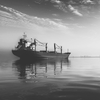There are a few other topics gathering more information than ballast water exchange, as the chorus of environmental damage from the scientific community and howls of reform from the legislative community grow louder each day. Two naval architects working with Teekay Shipping in Japan were recently involved in a study and have issued a paper on a more efficient way to handle the ballast water conundrum.
Ballast Water and Sediment Discharge is prohibited into coastal waters to minimize the risks of introduction of harmful marine organisms. Since management of ballast water discharge becomes mandatory, a ship is obliged to exchange ballast water in open ocean and as far as possible from coast. Two methods are introduced in IMO Resolution A.868 (20) adopted November 27, 1997. One is to empty a tank until suction is lost and pump in clean ballast water. The other is "Overflow Through Method" by pumping ballast water into the water overflow through the openings on the tank top. In both cases, a ship is required to run an electric/steam driven ballast pump and to monitor deballasting and ballasting operations, followed by running a diesel generator or firing a boiler which in turn creates an extra work load for the duty engineer.
A New Idea
To achieve ballast water exchange, clean water is guided from ship's bow front utilizing pressure difference of the stream along the hull surface of a running ship. The idea does not require any kind of ship's power except those for topping up operation to initial water level at final stage. A ship is free from an extra duty for operation and monitoring of auxiliary machinery. The system is applicable to all kinds of ship at any size, but the investigation was conducted on a model Aframax oil carrier.
The system consists of:
1) To provide a water inlet at Ship's Bow End, introduce and lead clean water in water ballast tank through existing Water Ballast Tank Main Line.
2) The water flowing in the tank with a certain positive pressure push away the biologically dirty water through the opening (Sea Chest), which is provided at forward bottom end of the tank.
However, each of the ships has its own bottom structure formed by girders and floors. Model tank tests were conducted to confirm the influence of bottom structure in relation to the location of water inlet points in the tank (bell mouth). Tests conducted confirmed the speed at which the Ballast Water is exchanged through the use of red-colored water in the model-Aframax ballast tank, which was constructed using transparent plastic.
Preliminary testing showed that approximately seven hours was sufficient to exchange 90 percent of the volume of the water in a 3,500 cu. m. tank, with a 400 mm diameter Ballast Water Main Line with the ship traveling 15 knots.
The model test was conducted for both single and double hulled Aframax tanker types, and it was confirmed that the most suitable location of the Water Outlet is at the forward end of the tank to have the longest water path to achieve the water exchange most effectively.
Sponsored Content
Chris-Marine’s solutions help to prolong engine lifetime

Subscribe for
Maritime Reporter E-News
Maritime Reporter E-News is the maritime industry's largest circulation and most authoritative ENews Service, delivered to your Email five times per week









